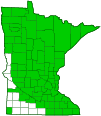Northern lady fern
(Athyrium angustum)
Conservation • Wetland • Description • Habitat • Ecology • Use • Distribution • Taxonomy
Conservation Status |
|||
| IUCN Red List | not listed |
||
| NatureServe | N5 - Secure SNR - Unranked |
||
| Minnesota | not listed |
||
Wetland Indicator Status |
|||
| Great Plains | FAC - Facultative |
||
| Midwest | FAC - Facultative |
||
| Northcentral & Northeast | FAC - Facultative |
||
Description |
Northern lady fern is a relatively large, delicate, perennial fern that rises from a short-creeping rhizome and fibrous roots. The rhizome is sometimes semi-erect and often branched. It usually has the bases of dead stalks still attached. It often forms small colonies. Sterile and fertile fronds are similar in appearance. The fronds are deciduous, erect, arching, 11½″ to 36″ long, and lacy in appearance. They form a compact, somewhat circular but irregular cluster. The leaf stem (stipe) is 6″ to 21½″ long, shorter than the leafy portion (blade). It is stout and light green or straw-colored for most of its length. It is flattened at the base and becomes deeply grooved toward the top. At the base it is dark reddish-brown or black, swollen, and has 2 rows of teeth. The stipe is covered with scattered chaffy scales. The scales are brown to dark brown, linear to egg lance-shaped, 5 ⁄16″ to ⅜″ long, and 1 ⁄16″ wide. The blade is elliptic, 12″ to 30″ long, 4″ to 14″ wide, 1 to 1½ times as long as the stipe. It is pinnately divided into 30 to 40 pairs of leaflets (pinnae). It tapers to a point with concave sides along the tip, and is widest below the middle. The 4th or 5th pair of pinnae is the largest pair. Only the lowest two pair are shortened. The lowest pair is conspicuously angled downward. The central axis of the blade (rachis) is pale green and usually hairless, sometimes sparsely glandular or hairy, sometimes with a few scattered scales. The pinnae are oblong lance-shaped, short stalked or stalkless, and taper to a narrow point with concave sides along the tip. The longest pinnae are up to 8″ long or longer, becoming shorter as they approach the tip. They are deeply, pinnately divided, with 12 to 20 segments (pinnules) per side. The pinnules are variable. They are linear to oblong, angled at the tip, and asymmetrically wedge-shaped at the base. They are stalkless and may extend along the central axis of the pinna (costa) at the base. They are often deeply lobed (pinnatifid), cut up to halfway or more to the midrib (costule). The upper and lower surfaces are medium green to yellow-green and hairless. The veins visible on the underside are forked. They are free, meaning they do not rejoin but extend all the way to the margin. The margins are minutely toothed, tough, and firm, but elastic. The rachis, costa, and costule have a V-shaped groove on the top. The groove of the costule connects with the groove of the costa, which connects to the groove of the rachis, which connects to the groove of the stipe. The reproductive structures are born on the underside of the pinnules near the base. There are several clusters (sora) of spore-bearing cases (sporangia) arranged in one row on each side of the midrib halfway between the midrib and the margin. The sorus is narrowly oblong to linear, usually straight, and sometimes hooked at the end or horseshoe-shaped with the hook curled over a vein. It is covered with a protective veil (indusium). The indusium is the same shape as the sorus. It is irregularly toothed and has a fringe of hairs along the margin. It is attached to one side of the sorus. There are 64 yellow or brown spores per sporangium. |
Height |
Fronds 11½″ to 36″ long |
Similar Species |
Common wood fern (Dryopteris intermedia) fronds are evergreen, not deciduous. The sori are round. The indusia are kidney-shaped and are attached at the base of the notch. Northwestern lady fern (Athyrium filix-femina var. cyclosorum) scales on the stipe are much larger, up to ¾″ long and 3 ⁄16″ wide. The blade is about 2 times as long as the stipe. It is broadest at or just above the middle. The sorus is always hooked or horseshoe-shaped. The indusium has a fringe of longer hairs along the margin, the hairs as longer or longer than the width of the indusium. The spores are always yellow. It has been reported only once in Minnesota, in Hennepin County. Spinulose wood fern (Dryopteris carthusiana) fronds are evergreen, not deciduous, and are usually smaller, no more than 30″ long. The sori are round. The indusia are kidney-shaped and are attached at the base of the notch. |
Habitat |
Moist. Bottomland forests, moist woods, meadows, thickets, swamps, streambanks. Dappled sunlight to light shade. |
Ecology |
Sporulation |
July to October |
Pests and Diseases |
|
Use |
|
Distribution |
||
|
Sources Biodiversity occurrence data published by: Minnesota Biodiversity Atlas (accessed through the Minnesota Biodiversity Atlas Portal, bellatlas.umn.edu, 9/10/2025). |
|
| 9/10/2025 | ||
Nativity |
||
| Native | ||
Occurrence |
||
Common and widespread |
||
Taxonomy |
|
Kingdom |
|
Division |
Tracheophyta (Vascular Plants) |
Subdivision |
Polypodiophytina |
Class |
Polypodiopsida (ferns) |
Subclass |
Polypodiidae (leptosporangiate ferns) |
Order |
Polypodiales |
Suborder |
Aspleniinae (eupolypods II) |
Family |
Athyriaceae (ladyferns and allies) |
Genus |
Athyrium (lady ferns) |
Section |
Athyrium |
There is considerable disagreement on the number and classification of the varieties of Athyrium filix-femina. Four varieties were traditionally recognized. The names of the varieties are one source of disagreement. Various authors have elevated one or more of the varieties to full species status. How many and which ones is another source of disagreement. Of the varieties, only northern lady fern (Athyrium filix-femina var. angustum) occurs outside of cultivation in Minnesota. When treated as a species, it is Athyrium angustum. Update |
|
Subordinate Taxa |
|
|
|
Synonyms |
|
|
Aspidium angustum Asplenium elatius Asplenium filix-femina var. angustum Asplenium michauxii Athyrium angustum var. angustum Athyrium angustum var. cristatum Athyrium angustum var. glanduliferum Athyrium angustum var. laurentianum Athyrium angustum var. rubellum Athyrium angustum var. subtripinnatum Athyrium angustum var. typicum Athyrium asplenioides var. angustum Athyrium filix-femina ssp. angustumn Athyrium filix-femina ssp. elegans Athyrium filix-femina var. angustum Athyrium filix-femina var. elegans Athyrium filix-femina var. michauxii Athyrium filix-femina var. rubellum Athyrium filix-foemina var. rubellum Athyrium michauxii |
|
Common Names |
|
common lady fern lady fern northeastern lady fern northern lady fern subarctic lady fern subarctic ladyfern |
|
Glossary
Costa
The central axis of a pinna, to which pinnules are attached.
Costule
The midrib of a pinnule.
Frond
A large leaf with many divisions: in ferns, the compound leaf, including the stipe and the blade; in mosses, a closely and regularly branched stem resembling a fern leaf; in lichens, a stalkless, leaf-like extension.
Indusium
Undergarment. In ferns: A veil covering the cluster (sorus) of spore-producing structures (sporangia). In fungi: A skirt-like structure hanging from the cap (receptacle) of a stinkhorn.
Linear
Long, straight, and narrow, with more or less parallel sides, like a blade of grass.
Pinna
The primary division of a compound leaf or fern frond.
Pinnate
On a compound leaf, having the leaflets arranged on opposite sides of a common stalk. On a bryophyte, having branches evenly arranged on opposite sides of a stem.
Pinnatifid
Deeply cut, more than half way to the midrib but not to the midrib, into lobes that are spaced out along the midrib; the lobes do not form separate leaflets.
Pinnule
The ultimate segment (individual leaflets) of a twice or more compound leaf or fern frond.
Rachis
The main axis of a compound leaf, appearing as an extension of the leaf stalk; the main axis of an inflorescence.
Rhizome
A horizontal, usually underground stem. It serves as a reproductive structure, producing roots below and shoots above at the nodes.
Sorus
A compact cluster of spore-bearing cases or sacs (sporangia) on a fern.
Sporangium
A spore bearing structure, as of a fern or moss.
Stipe
A supporting stalk-like structure lacking vascular tissue: in fungi, the stalk supporting the mushroom cap; in ferns, the stalk connecting the blade to the rhizome; in flowering plants, the stalk connecting the flower’s ovary to the receptacle; in orchids; the band connecting the pollina with the viscidium.
Visitor Photos
Share your photo of this plant.
This button not working for you?
Simply email us at info@MinnesotaSeasons.com.
Attach one or more photos and, if you like, a caption.
Luciearl |
||
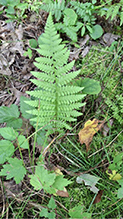 |
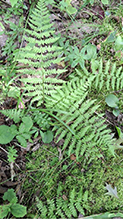 |
|
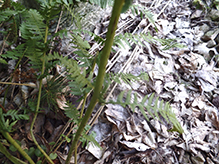 |
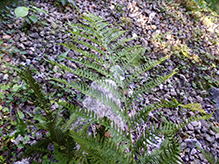 |
|
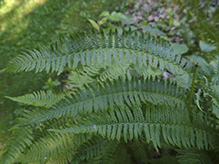 |
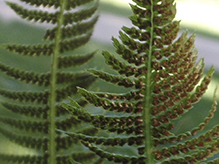 |
|
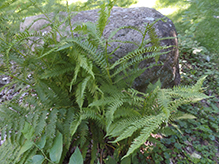 |
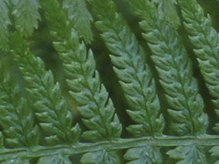 |
|
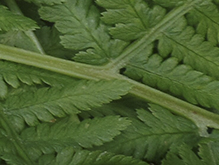 |
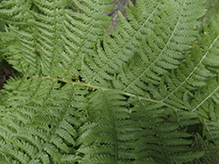 |
|
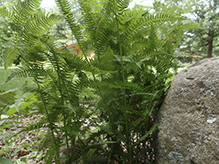 |
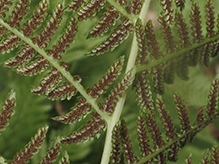 |
|
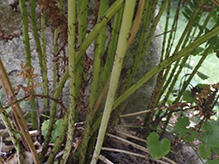 |
 |
|
MinnesotaSeasons.com Photos
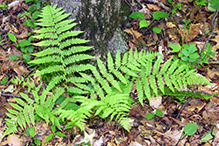 |
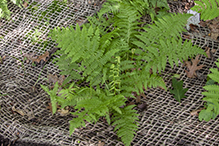 |
|
Plant |
Plant | |
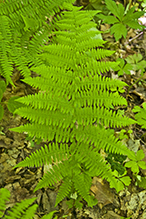 |
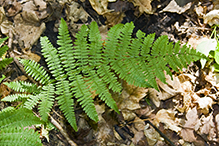 |
|
Frond |
||
|
||
|
||
Frond |
||
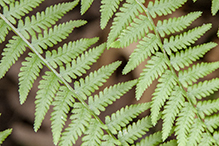 |
||
Pinnules |

Slideshows

Visitor Videos
Share your video of this plant.
This button not working for you?
Simply email us at info@MinnesotaSeasons.com.
Attach a video, a YouTube link, or a cloud storage link.
Other Videos
Athyrium filix femina
wander van laar
Lady Fern
Joe Addair

Visitor Sightings
Report a sighting of this plant.
This button not working for you?
Simply email us at info@MinnesotaSeasons.com.
Be sure to include a location.
MinnesotaSeasons.com Sightings
Avon Hills Forest SNA, North Unit
Bertram Chain of Lakes Regional Park
Carpenter St. Croix Valley Nature Center
Charles A. Lindbergh State Park
Clifton E. French Regional Park
Forestville/Mystery Cave State Park
Hardscrabble Woods / MG Tusler Sanctuary
John Peter Hoffman Spring Brook Valley WMA
Lake Alexander Woods SNA, South Unit
Mary Schmidt Crawford Woods SNA
Nerstrand Big Woods State Park
Robert Ney Memorial Park Reserve
Spring Beauty Northern Hardwoods SNA

